Shreyas Malakarjun Patil
Neural Sculpting: Uncovering hierarchically modular task structure through pruning and network analysis
Jun 03, 2023Abstract:Natural target functions and tasks typically exhibit hierarchical modularity - they can be broken down into simpler sub-functions that are organized in a hierarchy. Such sub-functions have two important features: they have a distinct set of inputs (input-separability) and they are reused as inputs higher in the hierarchy (reusability). Previous studies have established that hierarchically modular neural networks, which are inherently sparse, offer benefits such as learning efficiency, generalization, multi-task learning, and transferability. However, identifying the underlying sub-functions and their hierarchical structure for a given task can be challenging. The high-level question in this work is: if we learn a task using a sufficiently deep neural network, how can we uncover the underlying hierarchy of sub-functions in that task? As a starting point, we examine the domain of Boolean functions, where it is easier to determine whether a task is hierarchically modular. We propose an approach based on iterative unit and edge pruning (during training), combined with network analysis for module detection and hierarchy inference. Finally, we demonstrate that this method can uncover the hierarchical modularity of a wide range of Boolean functions and two vision tasks based on the MNIST digits dataset.
PHEW: Paths with higher edge-weights give "winning tickets" without training data
Oct 22, 2020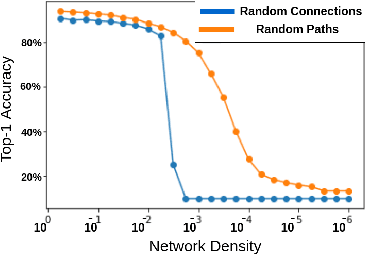
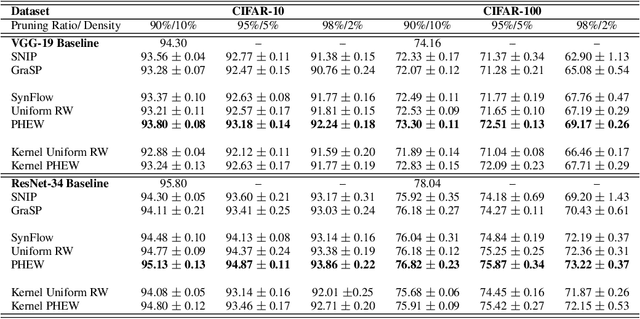
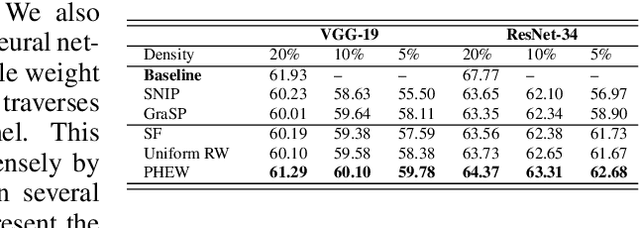

Abstract:Sparse neural networks have generated substantial interest recently because they can be more efficient in learning and inference, without any significant drop in performance. The "lottery ticket hypothesis" has showed the existence of such sparse subnetworks at initialization. Given a fully-connected initialized architecture, our aim is to find such "winning ticket" networks, without any training data. We first show the advantages of forming input-output paths, over pruning individual connections, to avoid bottlenecks in gradient propagation. Then, we show that Paths with Higher Edge-Weights (PHEW) at initialization have higher loss gradient magnitude, resulting in more efficient training. Selecting such paths can be performed without any data. We empirically validate the effectiveness of the proposed approach against pruning-before-training methods on CIFAR10, CIFAR100 and Tiny-ImageNet for VGG-Net and ResNet. PHEW achieves significant improvements on the current state-of-the-art methods at 10\%, 5\% and 2\% network density. We also evaluate the structural similarity relationship between PHEW networks and pruned networks constructed through Iterated Magnitude Pruning (IMP), concluding that the former belong in the family of winning tickets networks.
A Multi-task Framework for Skin Lesion Detection and Segmentation
Aug 05, 2018



Abstract:Early detection and segmentation of skin lesions is crucial for timely diagnosis and treatment, necessary to improve the survival rate of patients. However, manual delineation is time consuming and subject to intra- and inter-observer variations among dermatologists. This underlines the need for an accurate and automatic approach to skin lesion segmentation. To tackle this issue, we propose a multi-task convolutional neural network (CNN) based, joint detection and segmentation framework, designed to initially localize the lesion and subsequently, segment it. A `Faster region-based convolutional neural network' (Faster-RCNN) which comprises a region proposal network (RPN), is used to generate bounding boxes/region proposals, for lesion localization in each image. The proposed regions are subsequently refined using a softmax classifier and a bounding-box regressor. The refined bounding boxes are finally cropped and segmented using `SkinNet', a modified version of U-Net. We trained and evaluated the performance of our network, using the ISBI 2017 challenge and the PH2 datasets, and compared it with the state-of-the-art, using the official test data released as part of the challenge for the former. Our approach outperformed others in terms of Dice coefficients ($>0.93$), Jaccard index ($>0.88$), accuracy ($>0.96$) and sensitivity ($>0.95$), across five-fold cross validation experiments.
Siamese LSTM based Fiber Structural Similarity Network (FS2Net) for Rotation Invariant Brain Tractography Segmentation
Dec 28, 2017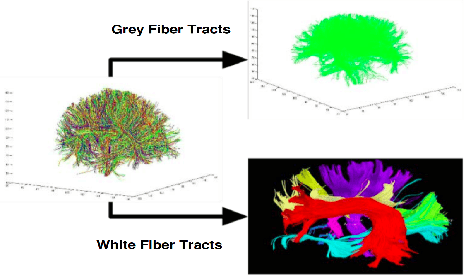
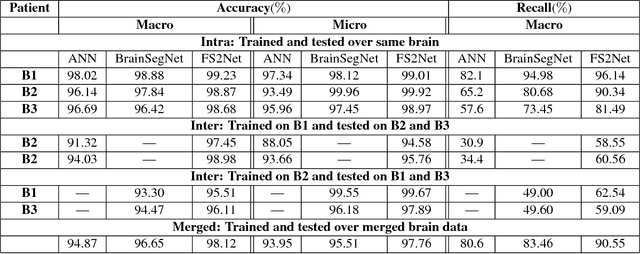
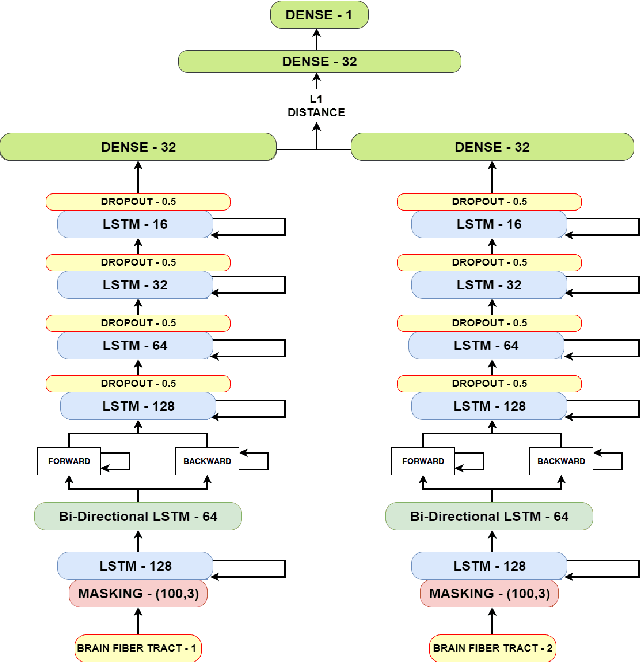
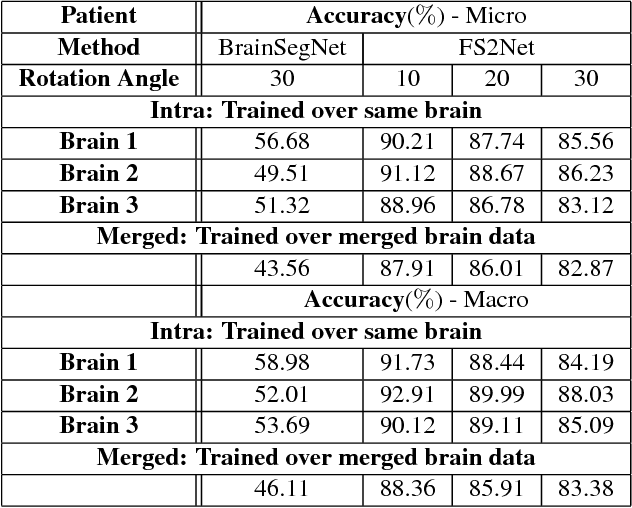
Abstract:In this paper, we propose a novel deep learning architecture combining stacked Bi-directional LSTM and LSTMs with the Siamese network architecture for segmentation of brain fibers, obtained from tractography data, into anatomically meaningful clusters. The proposed network learns the structural difference between fibers of different classes, which enables it to classify fibers with high accuracy. Importantly, capturing such deep inter and intra class structural relationship also ensures that the segmentation is robust to relative rotation among test and training data, hence can be used with unregistered data. Our extensive experimentation over order of hundred-thousands of fibers show that the proposed model achieves state-of-the-art results, even in cases of large relative rotations between test and training data.
BrainSegNet : A Segmentation Network for Human Brain Fiber Tractography Data into Anatomically Meaningful Clusters
Oct 14, 2017

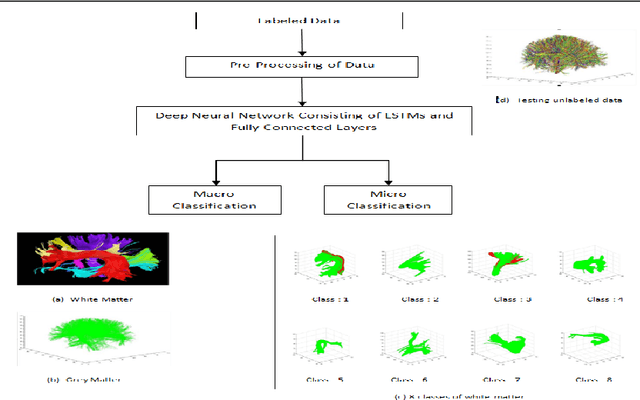
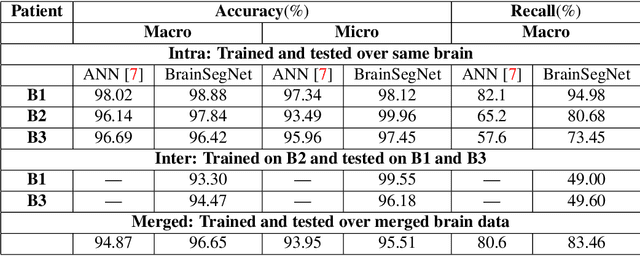
Abstract:The segregation of brain fiber tractography data into distinct and anatomically meaningful clusters can help to comprehend the complex brain structure and early investigation and management of various neural disorders. We propose a novel stacked bidirectional long short-term memory(LSTM) based segmentation network, (BrainSegNet) for human brain fiber tractography data classification. We perform a two-level hierarchical classification a) White vs Grey matter (Macro) and b) White matter clusters (Micro). BrainSegNet is trained over three brain tractography data having over 250,000 fibers each. Our experimental evaluation shows that our model achieves state-of-the-art results. We have performed inter as well as intra class testing over three patient's brain tractography data and achieved a high classification accuracy for both macro and micro levels both under intra as well as inter brain testing scenario.
UBSegNet: Unified Biometric Region of Interest Segmentation Network
Sep 26, 2017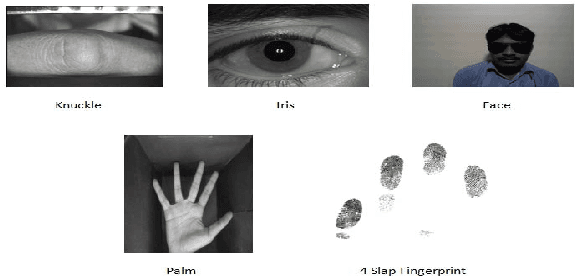
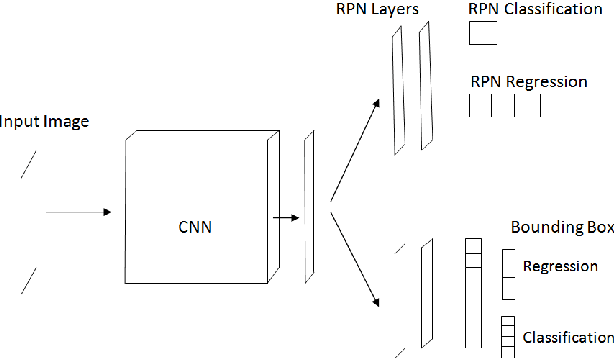
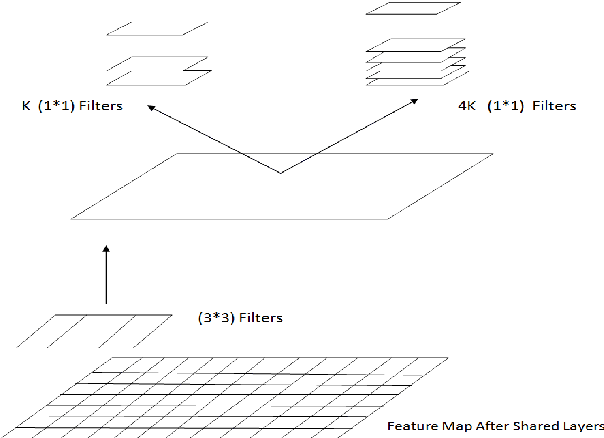
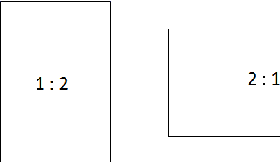
Abstract:Digital human identity management, can now be seen as a social necessity, as it is essentially required in almost every public sector such as, financial inclusions, security, banking, social networking e.t.c. Hence, in today's rampantly emerging world with so many adversarial entities, relying on a single biometric trait is being too optimistic. In this paper, we have proposed a novel end-to-end, Unified Biometric ROI Segmentation Network (UBSegNet), for extracting region of interest from five different biometric traits viz. face, iris, palm, knuckle and 4-slap fingerprint. The architecture of the proposed UBSegNet consists of two stages: (i) Trait classification and (ii) Trait localization. For these stages, we have used a state of the art region based convolutional neural network (RCNN), comprising of three major parts namely convolutional layers, region proposal network (RPN) along with classification and regression heads. The model has been evaluated over various huge publicly available biometric databases. To the best of our knowledge this is the first unified architecture proposed, segmenting multiple biometric traits. It has been tested over around 5000 * 5 = 25,000 images (5000 images per trait) and produces very good results. Our work on unified biometric segmentation, opens up the vast opportunities in the field of multiple biometric traits based authentication systems.
 Add to Chrome
Add to Chrome Add to Firefox
Add to Firefox Add to Edge
Add to Edge